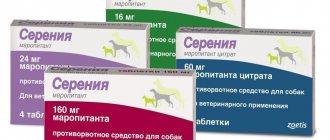Tired of sneezing, crying and coughing when there's a cat in the room? Find out whether the unpleasant symptoms are with you forever, and whether allergies to cats go away in children.
Some are allergic to chocolate, others to citrus fruits, others to pollen, but the most offensive thing is when the body simply cannot stand animals. The hope of bringing home a furry pet melts away after every close contact with cats, because it becomes clear that it will definitely not be possible to live with them in the same apartment. But some people secretly continue to believe that one day the day will come when there will be no trace of allergies left.
You can bring home the fluffiest cat you can find and enjoy her affection and restlessness. In fact, this is indeed possible, but not always.
Causes of pathology
Why does it occur? Allergic reactions are inadequate protective actions of the immune system in response to contact with substances that it perceives as hostile to the body, although in fact they do not pose a danger. In fact, this is a “misconception” of the system, caused by failures in its operation.
At the very first contact of allergenic substances with the body, protective antibodies are produced against them. And with repeated contacts, the immune system tries to counteract them. This is expressed in the desire to destroy alien agents. But at the same time, it is your own tissues that receive the greatest blow, and not imaginary enemies.
The main substances associated with cats that people are allergic to are:
- animal fur;
- saliva;
- peeling flakes of old skin;
- urine;
- feces.
Allergies to cat hair are the most common. The villi of different pets differ in their composition. This is why some people are only allergic to cats, while others are only allergic to dogs. Moreover, aggressive reactions of the immune system manifest themselves only to certain breeds of animals. There are hundreds of times more protein compounds (enzymes, immunoglobulins, lysozyme) in cat saliva than in human saliva. Moreover, their superactivity was revealed. The concentrated substance more strongly provokes the occurrence of pathological reactions, especially allergies to wool.
Since the keratin of cat skin is significantly different from human skin, its scales can also be perceived by the immune system as hostile agents. The urine of these pets contains proteins and acids in high concentrations, and therefore strongly irritates the skin and mucous membranes. The allergenicity of cat feces is due to the presence of mucus in them, which contains a lot of immunoglobulins and lymphocytes.
In addition, classic provocateurs of immune pathology enter the home along with pets: pollen, poplar fluff, street dust. Allergies to females may occur more often than to males. Cats with light fur have fewer hazardous substances than their dark-colored counterparts. This is the same difference between kittens and castrated individuals.
Polyps, growths and tumors in the nasal cavity of cats
The second most common respiratory tract disease in cats is nasopharyngeal polyps. These formations, overgrown areas of the epithelium, are dangerous because they continue to constantly grow.
Causes of polyps:
- chronic inflammation of the nasal cavity and inner ear;
- infectious runny nose in cats;
- allergic asthma;
- congenital defects of the nasopharynx.
Polyps are more often diagnosed in young animals under 2 years of age. The formations gradually grow from the nasal cavity into the ears, take on large sizes and prevent the cat from breathing and eating.
External manifestations of symptoms of the disease:
- discharge in the form of mucus from one nostril;
- sneezing and coughing;
- the pet snores and makes grunting sounds.
Polyps can be detected using an endoscope by feeling the soft palate with a finger.
Only magnetic resonance imaging can provide an accurate diagnosis, since soft tissues are not visible on X-rays.
Polyps are removed surgically under anesthesia, using forceps to grasp the body of the tumor along with the stalk.
Risk factors
Can a cat owner avoid cat allergies? This largely depends on the factors that provoke its appearance. They are divided into modifiable, i.e., controllable, and non-modifiable, which cannot be controlled.
The latter include:
- hyperfunction of the immune system;
- congenital enzyme deficiency;
- tissue hypersensitivity to allergic mediators (intermediaries);
- violation of control of their concentration;
- hereditary predisposition.
If disruptions occur in the child’s intrauterine development, the number of immune cells and antibodies in his blood increases significantly. The body's defenses are strengthened, but at the same time the risk of allergies increases.
To identify and destroy foreign agents before they enter the body, class A immunoglobulins and the natural antibiotic lysozyme are needed. When they are deficient, allergens easily enter inside and provoke attacks by the immune system.
The main mediators of allergies are serotonin, which is responsible for hyperemia and swelling of tissues, histamine, which causes itching, and bradykinin, which is responsible for pain. Even due to a small release of these hormones into the bloodstream, with increased tissue sensitivity to them, an allergic-type reaction may occur. Sometimes special cells of the brain, spleen, kidneys, liver, skin, which regulate the concentration of such mediators, are damaged.
It has been proven that predisposition to allergies is transmitted genetically. Pathology can manifest itself after 6 generations without affecting any of them, and occur in the descendants of the seventh generation.
This is why you can never be absolutely sure that a particular person does not have a hereditary predisposition to cat allergies.
Modifiable risk factors:
- hypertension;
- chronic inflammation of the digestive system;
- liver diseases;
- worms;
- aggressive environmental environment;
- unreasonable use of immunostimulant drugs (Arbidol, Anaferon, Broncho-munal, Derinat, Polyoxidonium, etc.);
- long-term treatment with ACE inhibitors (Enalapril, Captopril, Diroton, etc.);
- hypovitaminosis.
Entry of a foreign body into the respiratory tract
While playing, a cat may accidentally get a foreign body stuck in its nose. More often, during sneezing, a foreign body comes out, but can get caught on sharp ends and lead to severe inflammation.
What foreign bodies enter the respiratory system:
- small items not intended for cat play;
- plant seeds, sand and garbage on the street;
- small insects;
- food particles or fish bones;
- eggs and larvae of worms.
A sign that a cat has a foreign body in its nose is a change in behavior. The animal often sneezes, shakes its head, and backs away. Nasal discharge comes with blood if there is a sharp object there.
You can find out what got into the cat’s nose by external examination or using an endoscope. The most reliable way is ultrasound, which will determine the location and size of the foreign body. The owner can remove the object with tweezers if it is located near the nostrils, otherwise surgery will be required at a veterinary clinic.
Symptoms of pathology
When a cat allergy occurs, most people experience symptoms immediately. You just need to know them well so as not to mistake them for signs of many other diseases. Allergy to cats most often occurs from an early age in the form of the following typical symptoms:
- redness and itching in areas of contact with a pet;
- sneezing;
- nasal congestion, rhinitis, difficulty breathing;
- dry cough;
- lacrimation.
This is how cat allergies manifest in children. Most often this occurs in children with reduced immunity. The appearance of urticaria with an increase in temperature is typical for newborns. More acute symptoms may be seen in premature infants.
The pathology is more severe in newborns with a hereditary predisposition to such ailments. They can get sick even if there are no furry pets in the house - their allergens are easily transferred through the air, through clothing, and unwashed hands. Infants and children under one year of age often develop an allergy to cats if their immune system is weakened by frequent illnesses.
In advanced cases or with inadequate treatment, the following symptoms of allergy to cats in children are possible:
- severe skin rash;
- abdominal pain, diarrhea;
- vomit;
- breathing through the mouth;
- hoarse voice;
- swelling of the face;
- blue lips
How does a cat allergy manifest in an adult? The symptoms are the same as in children, with the exception of intestinal disorders. The skin often not only turns red and itches, but also peels off. In addition, these signs of cat allergy may be accompanied by an asthmatic manifestation - shortness of breath.
Diagnostics
You can find out if there is an allergy from the pet living in the house by undergoing an examination with an allergist. Since this pathology is characterized by many different functional abnormalities, it is often necessary to additionally consult a dermatologist, pulmonologist, nephrologist or therapist.
Before visiting a doctor, it is recommended to think through the exact wording of your complaints. The doctor’s clarifying questions must be answered as clearly as possible so as not to give false grounds for an erroneous diagnosis. Most often doctors ask:
- What exactly worries you the most?
- Is there a cat at home and for how long?
- Was there any direct contact with her before the painful symptoms appeared?
- Have you previously had allergic reactions to any substances other than saliva or cat skin particles?
- Do you have any relatives with allergies?
- What are the associated diseases?
- Have there been relapses of animal allergies and how often?
- What treatment was given previously?
- Were the prescribed medications effective?
How to test for cat allergies? If there is a rash, the doctor should examine the skin where it appears. It is imperative to show the doctor, without any embarrassment, all external signs of allergies, no matter where they are on the body. To recognize pathology, laboratory tests and special tests are practiced.
Most often, when diagnosing an allergy to a cat, you need to get the following results:
- general and biochemical blood tests;
- general urinalysis;
- immunograms;
- tests that identify a specific allergen;
- analysis for the presence of lymphocytes that are hypersensitive to cat tissues.
In the patient’s blood, if there is an allergy to cats, a significant amount of leukocytes, eosinophils, C-reactive protein and immune complexes, and an increase in ESR (erythrocyte sedimentation rate) are detected. When analyzing urine, a laboratory technician, if the pathology is allergic, often finds in it total protein, an excess of casts, and sometimes blood.
The patient's allergy is confirmed by an increased amount of class E immunoglobulins and the presence of lymphocytes with hypersensitivity to cat tissues. The results of scratch tests show: the larger the size of the inflammation around the scratch into which the allergen solution is applied, the stronger the immune system counteracts it.
Caution is the key to success
The most controllable situation for allergy symptoms is when there are no cats in the house. In this case, following the rules for eliminating contact with allergens reliably helps to cope with the symptoms:
- do not touch cats on the street;
- avoid visiting the habitats of stray cats - basements, backyards, areas with garbage cans;
- do not visit the houses of friends who have cats;
- When planning to receive guests, do not hesitate to delicately find out whether they are owners of furry pets. If this is the case, then it is better to organize a meeting in a cafe, on the street or in a park;
- when staying at home with cat owners is still necessary, preventive preparation should be carried out in advance. Start using antihistamines early. And politely ask the owners to at least isolate the cat in another room and ventilate the apartment.
Treatment methods
Is it possible to cure allergies due to cats completely? The task is complex, almost impossible. But it is quite possible to reduce the manifestations of the disease to a minimum. If you are allergic to cats, how can you get rid of the painful symptoms of this scourge? You need to change your lifestyle. First of all, it is necessary to permanently eliminate the factors that provoke pathological reactions. It is important to exclude all contact with cats.
What else should you pay attention to? You should also eat hypoallergenic foods to reduce the amount of inflammatory mediators. Frequent wet cleaning of your home is equally important.
To reduce the body's hypersensitivity to allergens, it is necessary to regularly carry out preventive courses of treatment. If you follow all these rules, the severity of the disease will certainly pass. Moreover, timely therapy will avoid severe irreversible complications.
How to deal with cat allergies? For this purpose, use:
- pharmaceuticals;
- traditional medicine;
- cosmetics for pet care.
How to cure cat allergies at home? You can start by regularly bathing them with special shampoos that wash out allergenic substances. To improve the patient’s condition, the attending physician, correlating symptoms and treatment of pathology, is guided by an integrated approach. It uses the potential of medications for both internal and external use.
Prevention of runny nose in cats
You can prevent your pet from sneezing and coughing by taking a number of measures:
- Make sure that there are no drafts in the room;
- Provide your cat with a balanced diet (with vitamins and minerals);
- Make the necessary vaccinations and show the animal to the veterinarian;
- If the animal is dried with a hairdryer, then there is no need to direct the stream towards the muzzle;
- Vaccination. Including from seasonal infections and changing living conditions;
- Deworming (treatment for parasites) using special means;
- Frequent wet cleaning of the premises;
- Isolation of household chemicals from animals.
The primary task during a runny nose is to establish the true causes of the disease (to do this, contact a veterinarian) and improve breathing. The animal can recover only under the close supervision of the owner and with proper care.
Pharmacy drugs and folk remedies
How to treat cat allergies with medications? The prescription of injection solutions, tablets, drops, gels, sprays, and ointments from the group of antihistamines is widely practiced. Diazolin, Tavegil, Suprastin, Loratadine, Telfast, Erius and other drugs for allergies to cats are effective.
Antihistamines Fenistil and Zyrtec in the form of drops are prescribed by doctors if an allergy to a cat is diagnosed in an infant. Any medications must be prescribed taking into account the age of the child, so as not to harm his health. Treatment is carried out at home. Hospitalization is required only for complications. If a child has a congenital allergy, sometimes as he grows it goes away on its own for a long time.
How to get rid of allergies to cats using folk remedies? Popular recipes:
- An effective way is to take 1 tbsp three times a day before meals. l. fresh celery juice.
- Allergies have long been cured using birch buds. 1 tbsp. l. raw materials pour 0.5 liters of water, boil for 15 minutes. Drink 150 ml 3-4 times a day before meals.
- Folk remedies include motherwort infusion, which is used to wash the nose and gargle. Pour 1 part of the herb into 5 parts of boiling water, leave for 2 hours. You can also use folk remedies on cats: it is recommended to frequently bathe your pets in this infusion.
- It is advisable to regularly add 1 tsp to food. zabrusa. Honeycomb wax seal is a good cure for cat allergies.











